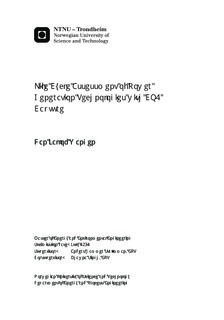Life Cycle Assessment of Power Generation Technologies with CO2 Capture
Master thesis
Permanent lenke
http://hdl.handle.net/11250/234920Utgivelsesdato
2012Metadata
Vis full innførselSamlinger
Sammendrag
Carbon Capture and Storage has large a potential to mitigating the CO2 emissions caused by fossil fuel powered power plants. CCS reduces the energy efficiency of the plant and increases the demand on chemicals and infrastructure. It is though not only the direct emissions from the power plants that have an impact on the environment. The entire supply chain of the power plant has an impact, and it is therefore necessary to evaluate the entire life cycle of the plant. This thesis consists of a full process LCA of post-combustion absorption based carbon capture and storage (CCS) technologies for both coal power plants and natural gas power plants. The assessed CCS technologies are based on the solvents MEA, MDEA and chilled ammonia. MEA is the most commonly used solvent in post-combustion capture, while MDEA and chilled ammonia represents novel CCS technologies that are still under development. It was shown that a 90% capture rate was possible for all of the assessed capture technologies. It was further shown that the total global warming potential (GWP) could be decreased with above 60%. 90% reduction is not possible because of indirect emissions in the supply chain. The reduction in GWP comes at a cost of decreasing energy efficiency, which further leads to an increase in consumption of materials and infrastructure. This causes the non-GHG related impacts to increase, compared to a base scenario without CCS. CCS technology based on MDEA was calculated to be the technology with the lowest impact, mainly because it has the lowest energy requirement. Chilled ammonia was assessed as the technology with the largest impacts. The reason for this is that the chilling process is very energy intensive and therefore decreases the efficiency more, compared to the other technologies assessed. Also the large emissions of ammonia have a large impact on the acidification potential and the marine eutrophication potential.
